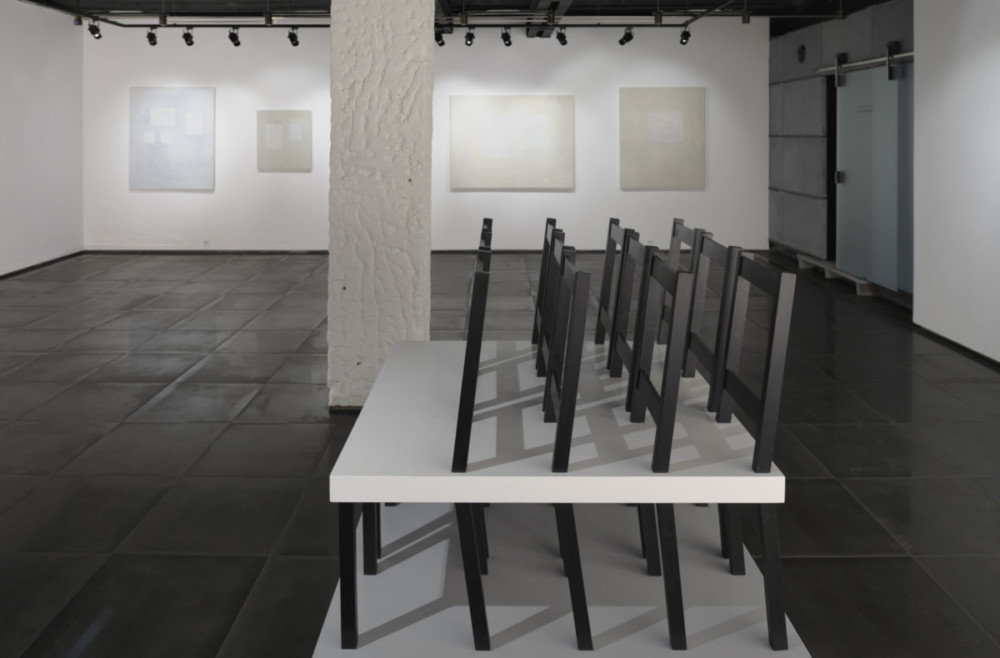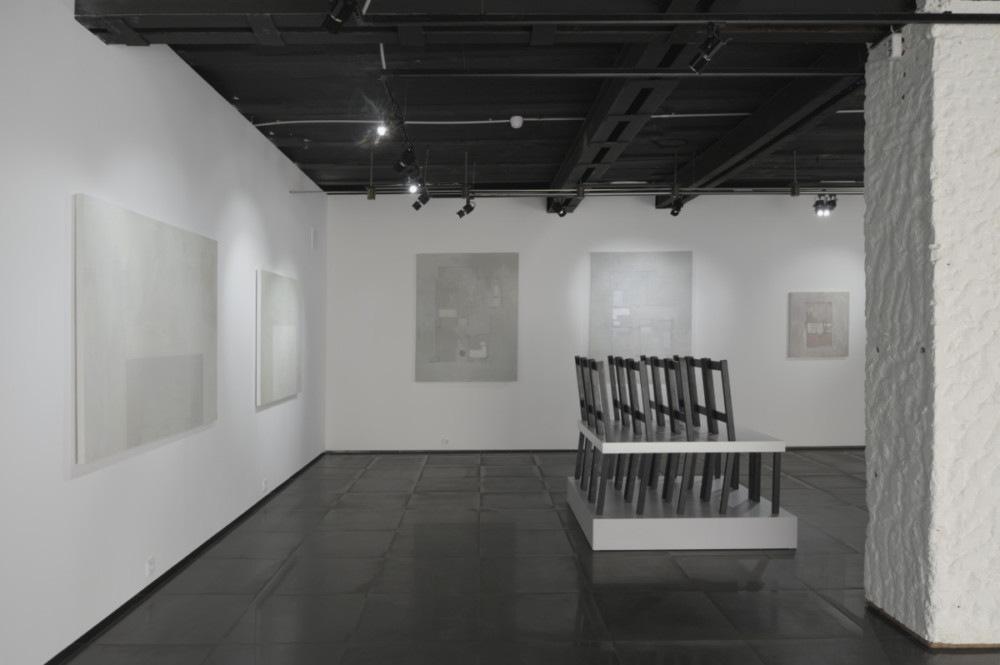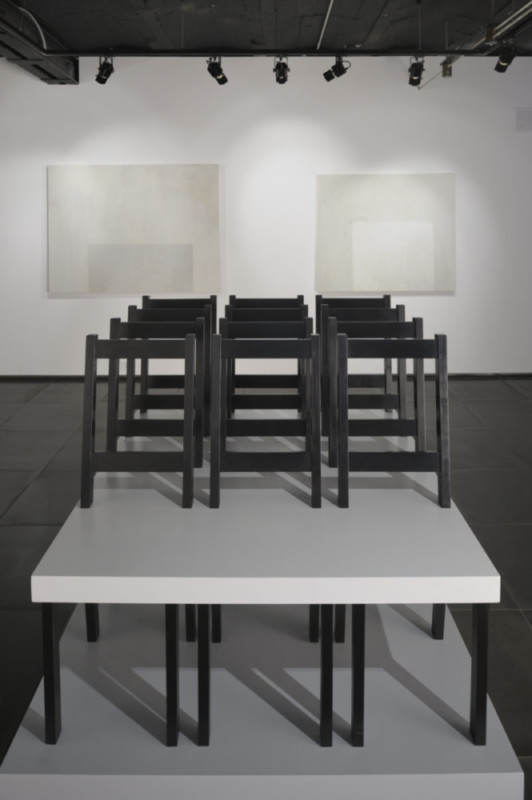Alexandra Paperno and Alexei Dushkin “Living Space/Zhilploschad” at Paperworks Gallery at Winzavod, Moscow, 2010
Exhibition views by Yuri Palmin
Plans, Walls, Furniture
Alexandra Paperno and Alexey Dushkin, artists with no history of joint exhibitions, play off one another here in a near perfect combination. Each artist’s contribution naturally highlights the merits of the other, combining to form a single multilayered composition.
Paperno’s paintings depict old walls and floor plans of standard apartments; Dushkin’s object represents rows of chairs fused so that only the first row can be used for its ostensible purpose. His “First Row,” positioned in the center of the exhibition, is surrounded by a background of Paperno’s canvases. This background plays an explicitly feminine role as a figure of absence (bare walls, floor plans of nonexistent apartments), with Dushkin’s object as the only solid presence (furniture, even if only conventionally). The paintings are rendered in multiple shades of gray, while the starkly colored black-and-white object serves as a fixed axis in the black-and-white gallery space – an axis and also a key to the semantics of the exhibition. Dushkin’s “furniture” has a symbolic functionality, positioning the viewer for the main feature – the panorama of canvases. “First Row”, appealing to constructivist stylistics, is also packed with associations involving the subordination of the private to the collective and the imposed discipline of the ancient Soviet past – from prison furnishings fastened to the floor and rigid school desks to the hard, fixed seats of a movie theater.
The latter association brings us back to the theme of the exhibition, which is essentially arranged like a film showing, with rows of seats (a material signifier of the viewer’s position and of vision itself) and a “screen” (the gallery walls with their succession of pictures). In a real theater the viewer’s position, eroded by the visual waves arising on the screen, remains unexamined, but here this position (together with the paintings as objects of visual perception) is presented as an object of contemplation in its own right. The pictures are arranged in a closed loop – a sort of panorama. To continue our comparison with the cinema, the closest analogy to this series of pictures would be a panoramic film, where the viewers stand and follow the events on screen by turning in a circle. An ordinary film, on the other hand, is viewed from a static, seated position with a strictly limited field of vision.
The arrangement of the Paperno-Dushkin exhibition combines a panoramic view with a limited viewpoint, and this combination is meaningful. In theory, we could take a seat in the front row of Dushkin’s furniture, and the solid, formal extension that largely gives the work its meaning would then be behind our backs and out of sight (as would much of Paperno’s work). The seen is thus fused with the unseen. Sight with insight.
It’s not a matter, though, of borrowing conceptual techniques and reducing the sensuality of images to the minimalism of cultural signs. Artistic tradition knows methods still more ecological. In order to understand what is involved here, we need to introduce an additional figure of comparison – the diorama. A dream factory that predates the cinema, the diorama creates its illusion by combining three-dimensional objects with two-dimensional images. In the Paperno-Dushkin exhibition we find something similar to a diorama, imperceptibly transforming real into imaginary space. But the similarity goes only so far, as the illusion here works in a very specific way, redirecting our gaze from the dimension of space to that of time and metaphor – from three-dimensional designer furniture to two-dimensional images of old walls bearing the traces of things that once hung on them.
One reason why a diorama works better as an analogy than the cinema is the former’s orientation on the past. The artists gently reorient us from “here” to “there” and from “now-today” to “then-yesterday” before upending our line of sight and elevating us to a point where we can look down on the floor plans. But it’s not only a view from above, because these plans do more than partition space; they map out a would-be life in virtual square meters – a life that is yet to be or now never to be, surviving only as a plan for happiness within four walls and holding us in the imaginary/metaphorical state of existence most natural for humankind – the past-future (or future in the past) – without any sense of a present.
The process of vision is tied to the present, but once vision itself becomes the spectacle, it is inverted, diffused in self-contemplation, entertained by the sensory fluctuations that arise when vision forgets itself in the contemplation of something external. It’s not surprising, then, that the external object of contemplation in an exhibition structured in this way should be (to repeat myself) bare walls showing only the shades of things (the past). Or that the geometrically composed pictures of these walls should look so much like the pictures of floor plans (the future). All these rhyming rectangles of the imagined past/future serve as the pretext for a very painterly metaphysics – a metaphysics of the single present, manifesting as a continuum of plastic modulations and constituting the central theme of this work devoted entirely to vision. It lives in the attention of our eyes and hardens in words and interpretations. Its quality determines the coherence of the three times in our awareness, the intensity of perception that fuels speculation and invention, the persistence of memory and the brightness of anticipation.
Paperno’s work is extended – not only in terms of the time it takes to produce, but in terms of its density, attenuated to the point of insubstantiality. The arrangement of the color mass draws our gaze from the surface deep into the interior and back again both spatially and temporally and somewhere inside eliminates the sense of time altogether, leaving only distance as such. And the distance felt and explored in this work is experienced not as alien but as something kindred – and thematically elaborated in the exhibition space. Dushkin, with his neo-constructivism, points to futuristic Soviet design as a source of inspiration and to Soviet culture in general as an open field of possibility for the creation of today’s forms. At the same time, the rudimentary subjects of Paperno’s paintings, imbued with a nostalgic sensibility, transform the Soviet aura, emptying it of all ideological content, while preserving its original tone, originating not in the last century’s monstrous history, but somewhere in the gap/link between that history’s plans and its ruins – a tone familiar to all who knew something of the residual life and cultural dreams of the era of late communism.
Vladimir Levashov



